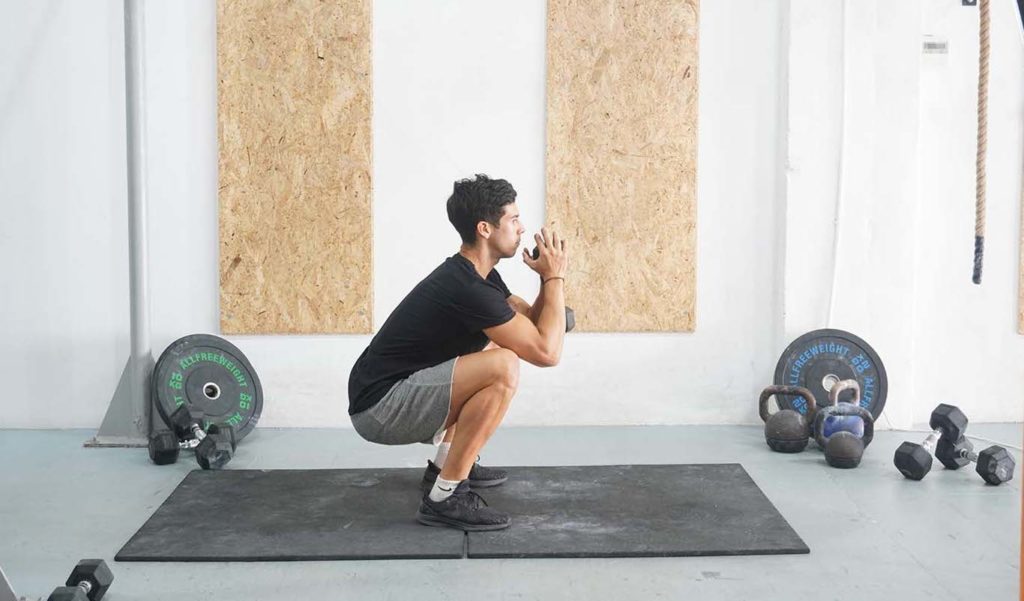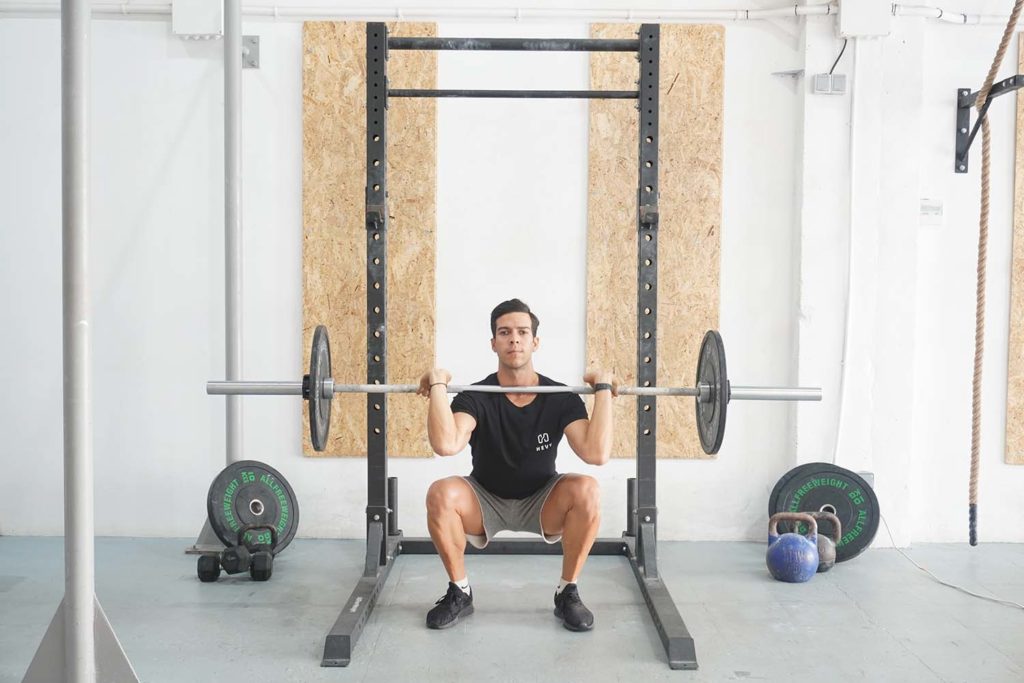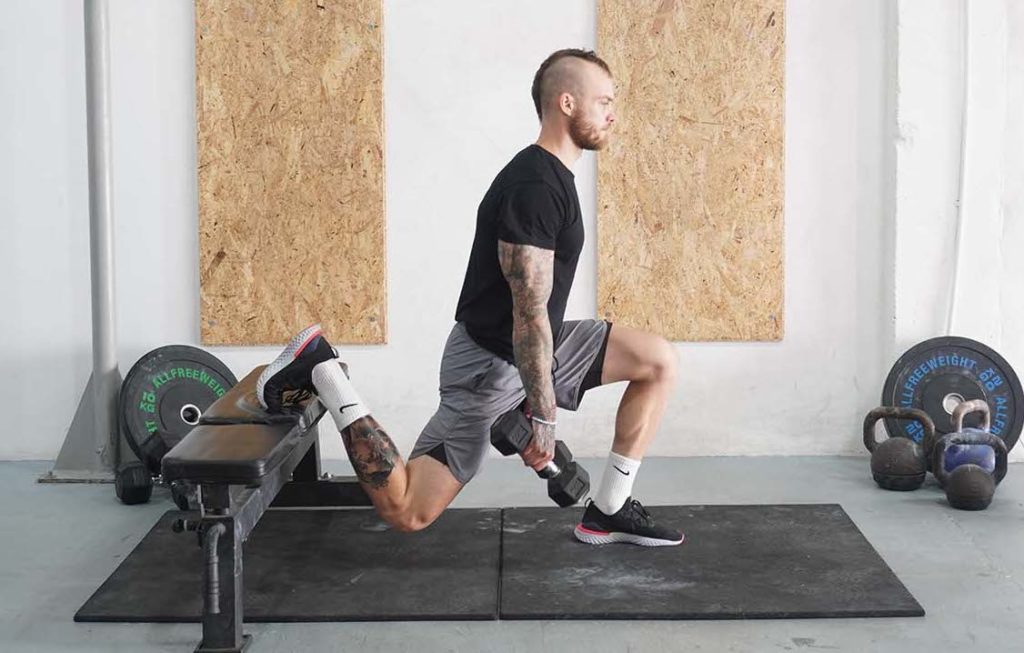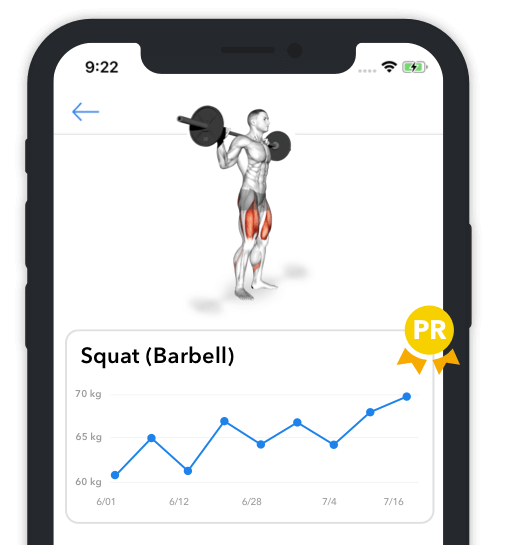What is a Kettlebell Goblet Squat?
Kettlebell goblet squats are a fantastic assistance exercise that strengthens your quadriceps, core, upper back, and shoulders. The objective is to grab a kettlebell, lift it in front of your chest and perform squats. Doing so forces you to maintain a more upright posture, which leads to better activation in the arms, shoulders, abs, and upper back.
A notable benefit of goblet squats is that you work your quadriceps better. Having a more upright torso prevents you from relying on hip extension, and your quadriceps have to work extra hard to create knee extension.
Using a kettlebell is not that different from using a dumbbell, and you’re working the same muscles and training through an identical range of motion. Using a barbell is different because you must support it on top of your shoulders instead of holding it in front of your chest.
We recommend including the kettlebell goblet squat near the middle of your lower body workouts. Pick a moderately-heavy dumbbell and do between 10 and 15 reps on each set.
Level of Exercise: Intermediate
How to do a Kettlebell Goblet Squat

- Grab a kettlebell by the horns––both sides of the handle with palms facing one another.
- Lift the weight in front of your chest with your elbows bent. Keep the kettlebell close to your body.
- Bring your shoulders back and position your feet in a comfortable stance with toes pointing slightly out.
- Take a breath and engage your abs.
- Descend by bending your knees and maintaining an upright torso as you move down.
- Squat until your thighs are parallel to the floor and your elbows are between your thighs.
- Hold the bottom position for a moment.
- Push through your heels to move up, keeping the kettlebell close to your body.
- Exhale as you straighten your legs.
- Take another breath and repeat.
What muscles does the kettlebell goblet squat activate?
The primary muscles that work during the kettlebell goblet squat are the quadriceps, which make up the front of our thighs and produce knee extension (straightening of the legs) (1, 2). Our quadriceps activate as we start moving down and produce a lot of force to move back to the top. Holding the kettlebell in front of your torso forces you to stay more upright, which leads to superior quad activation.
Our hamstrings and glutes also contribute during goblet squats, but not much. Hip extension occurs to a lesser degree compared to other movements, such as low-bar back squats. The primary role of the glutes and hamstrings is to keep our pelvis and knees stable throughout the exercise.
The entire midsection musculature also works during goblet squats. All of the muscles in the area flex isometrically to provide torso support, allowing us to do repetitions and support the kettlebell in front of our chest. Similarly, the upper back musculature contributes to shoulder and torso stability.
Our shoulders, biceps, and forearms engage to help us support the kettlebell in front of us as we squat.
Tips on Technique and Form when Performing a Kettlebell Goblet Squat
A crucial piece of advice for safe goblet squats is to start with a light kettlebell and learn how to perform the movement. Using too much weight can cause your back to round, increasing the risk of falling forward or shortening the range of motion. Pick a weight that allows you to perform at least ten good repetitions per set.
Our second tip for the movement is to keep the weight close to your chest from start to finish. Doing so allows you to create a natural ‘shelf’ for the weight to rest upon, reducing the tension on your shoulders and biceps. Keeping the kettlebell too far forward makes it more challenging to maintain balance and increases the risk of overworking the relatively small supporting muscles.
The third thing to keep in mind for goblet squats is to sit back into your heels as you descend. Doing so is vital for performing the squat correctly by keeping your weight on your heels and torso upright. Many trainees lean forward and place more weight on the balls of their feet as they squat, increasing the risk of losing their balance.
Variations and Modifications of the Kettlebell Goblet Squat
1. Pause Goblet Squat
Pause goblet squats are an effective variation that improves your technique and leads to better muscle activation. The objective is to descend and hold the bottom position for at least two seconds. Doing so prevents you from ‘bouncing’ off the bottom and instead forces your quadriceps to work extra hard.
2. Dumbbell Goblet Squat

Dumbbell goblet squats are simply a variation you perform by holding a dumbbell instead of a kettlebell. You must position the dumbbell vertically and place your palms against the top weight plate. The exercise is identical to kettlebell squats, and picking between a dumbbell and kettlebell mostly comes down to convenience.
3. Sumo Goblet Squat
Sumo goblet squats are a variation you perform by spreading your feet wider than usual. Doing so is beneficial for engaging your adductors (inner thigh muscles) more effectively.
Mistakes to Avoid
Shortening the Range of Motion
One of the most common mistakes with any squat is shortening the range of motion. Trainees often lack the necessary mobility for a full range of motion squatting or use too much weight that stops them from reaching the bottom. Avoid the error by starting with bodyweight squats to assess your range of motion. If mobility isn’t an issue, begin with a light kettlebell and always descend until your thighs are parallel to the floor before moving back up.
Leaning Forward
The second common error with goblet squats is leaning forward. Doing so is bad because it shifts your weight over the balls of your feet, causing you to lose your balance and fall forward. Avoid the mistake by sitting back into your heels as you move down. That way, you’ll be able to maintain an upright torso more efficiently and keep the weight closer to your center of gravity.
Holding the Weight Away From Your Body
The third mistake with goblet squats is not keeping the weight close to your chest. Doing so puts unnecessary pressure on your biceps and deltoids, leading to fatigue and forcing you to stop the set before you’ve stimulated your quadriceps. Instead, you should keep the kettlebell close to your chest. You might even rest the weight against your torso if that feels comfortable.
Similar Exercises to the Kettlebell Goblet Squat
Front Squat

Front squats are familiar to goblet squats in many ways. You must support the weight in front of your body and maintain a relatively upright torso. Doing so leads to better quadriceps activation and prevents your posterior chain musculature (glutes and hamstrings) from taking over (3).
Bulgarian Split Squat

Bulgarian split squats are an excellent accessory exercise that develops your quadriceps and glutes (4). The objective is to elevate your rear leg on a gym bench, plyo box, chair, or something sturdy, bring the front leg forward, and squat. Doing so is fantastic for developing both sides of your body evenly and preventing muscle imbalances.



